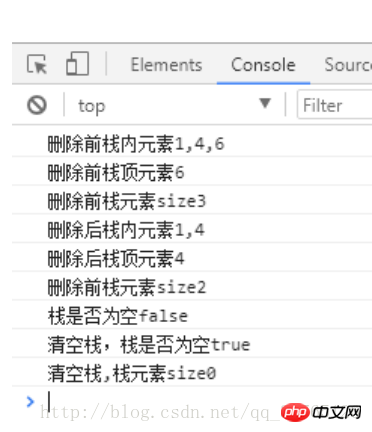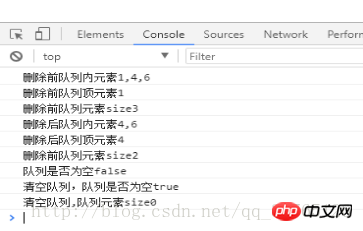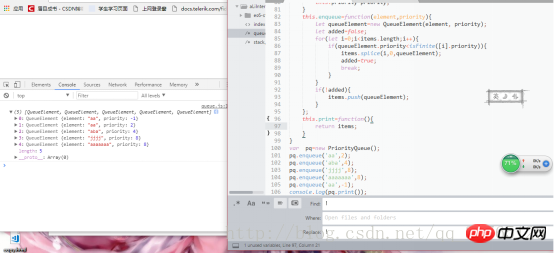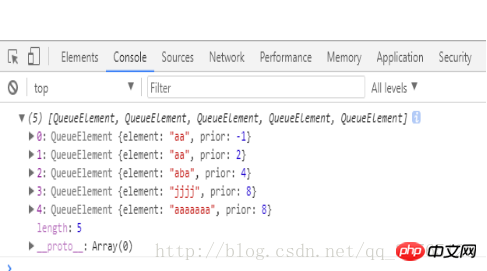資料結構有講過,堆疊是一種遵從後進先出原則的有序集合,書中對棧的形容非常到位,就像是堆盤子,先放的肯定在下面的位置,最上面的是才放的。在棧內加入元素,最先加入的在棧底,最後一個加進去的稱為棧頂元素。
具體內容有
#建立堆疊:在js裡我們用陣列類別比堆疊
#新增元素push()


 # #
# #
function Stack(){
var stack=[]; this.push=function(para){
stack.push(para);
}; this.delete=function(){
// 删除栈顶元素
stack.pop();//删除数组末尾元素,
} this.size=function(){
return stack.length;
} this.peek=function(){
return stack[stack.length-1];
} this.isEmpty=function(){
if(stack.length==0){ return true;
}else{ return false;
}
} this.emptyStack=function(){
stack=[];
} this.print=function(){
return stack.toString();
}
}var myStack=new Stack(); myStack.push(1); myStack.push(4); myStack.push(6); console.log('删除前栈内元素'+myStack.print()); console.log('删除前栈顶元素'+myStack.peek()); console.log('删除前栈元素size'+myStack.size()); myStack.delete(); console.log('删除后栈内元素'+myStack.print()); console.log('删除后栈顶元素'+myStack.peek()); console.log('删除前栈元素size'+myStack.size()); console.log('栈是否为空'+myStack.isEmpty()); myStack.emptyStack(); console.log('清空栈,栈是否为空'+myStack.isEmpty()); console.log('清空栈,栈元素size'+myStack.size());
 隊列#先進先出,就像喝孟婆湯要排隊一樣,先來的排在前面,後面來的就排在隊尾,要投胎肯定是前面喝完的人去,操作隊列也一樣,從隊列前面移除元素,從隊尾添加元素。和堆疊的實作大同小異
隊列#先進先出,就像喝孟婆湯要排隊一樣,先來的排在前面,後面來的就排在隊尾,要投胎肯定是前面喝完的人去,操作隊列也一樣,從隊列前面移除元素,從隊尾添加元素。和堆疊的實作大同小異function Queue(){
var queue=[]; this.push=function(para){
queue.push(para);
} this.delete=function(){
// 从队首移除,即删除的是数组第一位
queue.shift();
} this.queueFront=function(){
return queue[0];
} this.isEmpty=function(){
if(queue.length==0){ return true;
}else{ return false;
}
} this.size=function(){
return queue.length;
} this.emptyQueue=function(){
queue=[];
} this.print=function(){
return queue.toString();
}
}var myQueue=new Queue();
myQueue.push(1);
myQueue.push(4);
myQueue.push(6);
console.log('删除前队列内元素'+myQueue.print());
console.log('删除前队列顶元素'+myQueue.queueFront());
console.log('删除前队列元素size'+myQueue.size());
myQueue.delete();
console.log('删除后队列内元素'+myQueue.print());
console.log('删除后队列顶元素'+myQueue.queueFront());
console.log('删除前队列元素size'+myQueue.size());
console.log('队列是否为空'+myQueue.isEmpty());
myQueue.emptyQueue();
console.log('清空队列,队列是否为空'+myQueue.isEmpty());
console.log('清空队列,队列元素size'+myQueue.size());實作的不同點刪除操作和存取隊首(堆疊頂)元素的方法不一樣,這是由於後進先出和先進先出的原則不同造成的,棧刪除的是數組最後一位( pop() ),隊列刪除數組的第一位(shift()),棧頂元素是數組最後一位,而隊列的隊首元素是數組第一位元素。
書上有用ES6的新特性寫的實現方式,emmmm我ES6不甚了解,等以後以後以後~~~補充,優先隊列
#說白了就是有特權,書中規定優先順序小的在前面。然後自己實作了一下,程式碼和書裡不太一樣,兩個都運行了一下
先貼一下書上的程式碼function PriorityQueue(){
let items=[]; function QueueElement(element,priority){
this.element=element; this.priority=priority;
} this.enqueue=function(element,priority){
let queueElement=new QueueElement(element, priority); let added=false; for(let i=0;i<items.length;i++){ if(queueElement.priority<isFinite([i].priority)){
items.splice(i,0,queueElement);
added=true; break;
}
} if(!added){
items.push(queueElement);
}
}; this.print=function(){
return items;
}
}var pq=new PriorityQueue();
pq.enqueue('aa',2);
pq.enqueue('aba',4);
pq.enqueue('jjjj',8);
pq.enqueue('aaaaaaa',8);
pq.enqueue('aa',-1);
console.log(pq.print());
function PriorityQueue(){
// 按优先级从小到大排列,
var queue=[]; function QueueElement(ele,prior){
this.element=ele; this.prior=prior;
} this.enqueue=function(ele,prior){
//循环遍历队列内所有元素,如果当前优先级小,则放在该位之前
var curr=new QueueElement(ele, prior); if(queue.length==0){
queue.push(curr);
}else{ if(curr.prior<=queue[0].prior){
queue.splice(0,0,curr);
}else{
queue.push(curr);
}
}
} this.print=function(){
return queue;
}
}var pq=new PriorityQueue();
pq.enqueue('aa',2);
pq.enqueue('aba',4);
pq.enqueue('jjjj',8);
pq.enqueue('aaaaaaa',8);
pq.enqueue('aa',-1);
console.log(pq.print());
嗷嗷嗷截圖才發現最後應該輸出element,不要優先級,這裡補一下上面兩個的print方法(注意,我聲明的是queue,書中是items ^_^)this.print=function(){
var result=[]; for(let j = 0, length2 = items.length; j < length2; j++){
result[j]=items[j].element;
}
return result;
}
鍊錶儲存有序的元素集合,但不同於陣列的是,鍊錶中的元素並不是連續放置的。每個元素由儲存元素本身的節點和一個指向下一個元素的參考(指標)構成,單鍊錶
append(para) 在链表尾部添加元素appendAt(element,index) 在指定位置添加元素deleteAt(index) 删除指定位置的链表元素getHead() 获得链表头元素size() 获得链表大小print() 打印出链表内容 toString() 输出链表元素的内容indexOf(para) 查找元素如果在链表中找到了就返回他的位置,没找到就返回-1isEmpty() 判断链表是否为空size() 获取链表长度
function LinkList(){
let Node=function(element){
this.element=element; this.next=null;
}; var list=[];
let length=0;
let head=null;
let currNode=null; this.append=function(para){
//链表尾部追加元素
var node=new Node(para); var current;//一直指向上一个添加的节点
if(head==null){ //插入第一个元素
head=node;
currNode=head; // console.log(head);
}else{ //不是第一个元素
//上一个的next指针指向当前node;
currNode.next=node; // console.log(currNode);
currNode=node;
}
length++; // list.push(node);
} this.getHead=function(){
return head;
} this.appendAt=function(element,index){
if(index>=0 && index<=length){ var node=new Node(element); var current=head; var previous; var position=0; if(index==0){
node.next=current;
head=node;
}else{ while(position++<index){
previous=current;
current=current.next
}
node.next=current;
previous.next=node;
}
length++; // return
}else{
alert("参数错误");
}
} this.deleteAt=function(index){
//从特定位置移除一个元素,index索引
if(index>=0 && index<length){ var previousNode=null; var node=head; var position=0; if(index==0){
head=node.next; return node.element;
}else{ // console.log(node);
while(position++<index){ // console.log(node);
previousNode=node;
node=node.next;
}
previousNode.next=node.next; return node.element;
}
}else{
alert("参数不正确!"); return null;
}
length--;
} this.size=function(){
return list.length;
} this.print=function(){
var result=[]; for(let i = 0, length1 = list.length; i < length1; i++){
result[i]=list[i];
} return result;
}
}var linkList=new LinkList(); linkList.append('lorry1'); linkList.append('lorry2'); linkList.append('lorry3'); linkList.appendAt('lorry4',0); linkList.appendAt('lorry5',0);// 那么当前链表的元素顺序是 lorry5,lorry4,lorry1,lorry2,lorry3console.log(linkList.deleteAt(2)); console.log(linkList.getHead().next);//获取头元素的下一个元素
控制台打印出来的内容:lorry1 linkList.js:112 Node {element: "lorry4", next: Node} linkList.js:115
element:"lorry4"
next:Node {element: "lorry2", next: Node}
__proto__:Objectthis.toString=function(){
var current=head; var str=''; var i=0; while(current){
str+=current.element+' ';
current=current.next;
} return str;
} this.indexOf=function(para){
//返回首个出现该参数的位置
var current=head; var index=-1; // var i=0;
while(current){
index+=1; if(current.element==para){ return index;
}
current=current.next;
} return -1;
} this.isEmpty=function(){
return length==0;
} this.size=function(){
return length;
}var linkList=new LinkList(); linkList.append('lorry1'); linkList.append('lorry2'); linkList.append('lorry3'); linkList.appendAt('lorry4',0); linkList.appendAt('lorry5',1); linkList.appendAt('lorry5',0);console.log('我删除了...'+linkList.deleteAt(1));console.log('头元素下一个元素是...'+linkList.getHead().next.element);console.log('删除后链表内容...'+linkList.toString());console.log('lorry5在链表中的位置...'+linkList.indexOf('lorry5'));console.log('lorriy5在链表中的位置....'+linkList.indexOf('lorriy5'));console.log('链表长度...'+linkList.size());
linkList.js:143 我删除了...lorry4linkList.js:145 头元素下一个元素是...lorry5linkList.js:146 删除后链表内容...lorry5 lorry5 lorry1 lorry2 lorry3 linkList.js:147 lorry5在链表中的位置...0linkList.js:148 lorriy5在链表中的位置....-1linkList.js:150 链表长度...5
以上是js堆疊、佇列、鍊錶資料結構的實作程式碼分享的詳細內容。更多資訊請關注PHP中文網其他相關文章!




